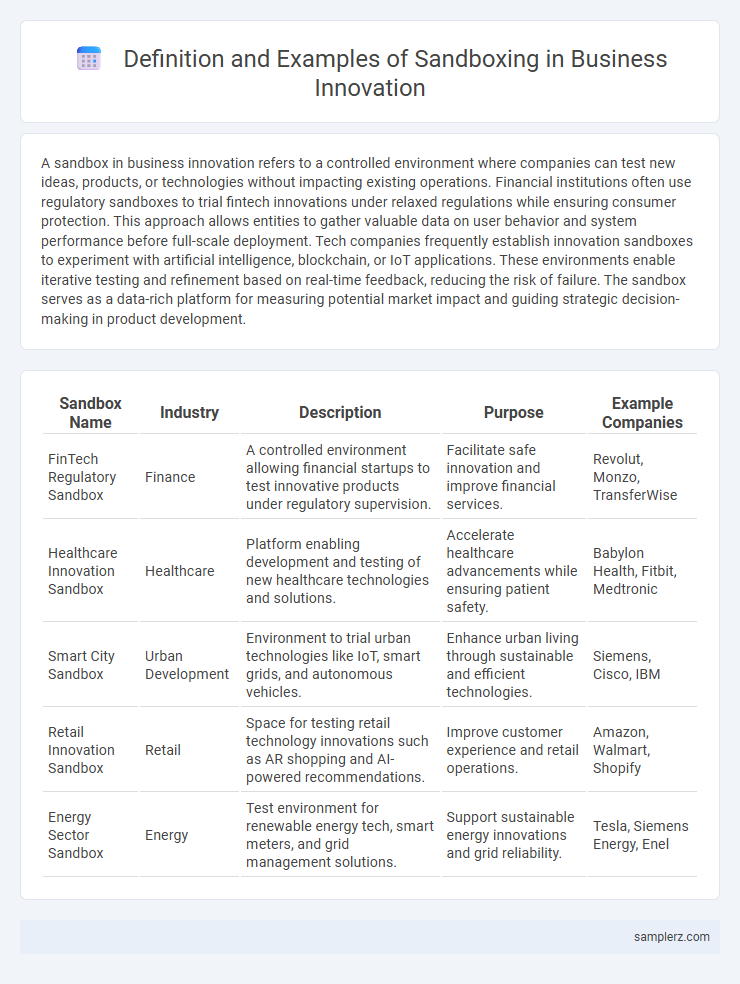A sandbox in business innovation refers to a controlled environment where companies can test new ideas, products, or technologies without impacting existing operations. Financial institutions often use regulatory sandboxes to trial fintech innovations under relaxed regulations while ensuring consumer protection. This approach allows entities to gather valuable data on user behavior and system performance before full-scale deployment. Tech companies frequently establish innovation sandboxes to experiment with artificial intelligence, blockchain, or IoT applications. These environments enable iterative testing and refinement based on real-time feedback, reducing the risk of failure. The sandbox serves as a data-rich platform for measuring potential market impact and guiding strategic decision-making in product development.
Table of Comparison
| Sandbox Name | Industry | Description | Purpose | Example Companies |
|---|---|---|---|---|
| FinTech Regulatory Sandbox | Finance | A controlled environment allowing financial startups to test innovative products under regulatory supervision. | Facilitate safe innovation and improve financial services. | Revolut, Monzo, TransferWise |
| Healthcare Innovation Sandbox | Healthcare | Platform enabling development and testing of new healthcare technologies and solutions. | Accelerate healthcare advancements while ensuring patient safety. | Babylon Health, Fitbit, Medtronic |
| Smart City Sandbox | Urban Development | Environment to trial urban technologies like IoT, smart grids, and autonomous vehicles. | Enhance urban living through sustainable and efficient technologies. | Siemens, Cisco, IBM |
| Retail Innovation Sandbox | Retail | Space for testing retail technology innovations such as AR shopping and AI-powered recommendations. | Improve customer experience and retail operations. | Amazon, Walmart, Shopify |
| Energy Sector Sandbox | Energy | Test environment for renewable energy tech, smart meters, and grid management solutions. | Support sustainable energy innovations and grid reliability. | Tesla, Siemens Energy, Enel |
Introduction to Sandboxes in Business Innovation
Sandboxes in business innovation serve as controlled environments where companies can test new products, services, or processes without impacting core operations. Financial technology firms often use regulatory sandboxes to experiment with novel payment solutions under the supervision of authorities, ensuring compliance and risk management. This approach accelerates innovation, reduces market entry barriers, and fosters collaboration between startups and regulators.
Key Features of Innovation Sandboxes
Innovation sandboxes offer a controlled environment where businesses can test new ideas with real users and data while minimizing risks. Key features include regulatory flexibility, iterative experimentation, and real-time feedback loops to refine innovations before full-scale deployment. These sandboxes enable faster validation of products or services, promoting agile development and reducing time-to-market.
Real-World Sandbox Examples in Corporations
Google's Area 120 functions as an internal innovation sandbox, enabling employees to develop and test experimental projects without the constraints of traditional corporate processes. Amazon's Alexa Fund serves as a real-world sandbox by investing in startups focused on voice technology, accelerating innovation with practical market feedback. Microsoft's Garage initiative acts as a corporate sandbox, fostering grassroots innovation through cross-functional teams that prototype new ideas directly aligned with user needs.
Regulatory Sandboxes in Fintech Innovation
Regulatory sandboxes in fintech innovation provide a controlled environment where startups can test new financial products and services under regulatory supervision, reducing compliance risks and accelerating market entry. Examples include the Financial Conduct Authority (FCA) sandbox in the UK and the Monetary Authority of Singapore's (MAS) Sandbox Express, both fostering fintech advancements while ensuring consumer protection. These initiatives enable iterative testing, collaboration between regulators and innovators, and support transformative financial technologies such as blockchain, digital payments, and AI-driven lending platforms.
Sandbox Success Stories: Case Studies
Leading tech giants like Google and Amazon have leveraged innovation sandboxes to accelerate product development and test disruptive ideas in controlled environments. Financial institutions such as JPMorgan Chase have employed regulatory sandboxes to pilot blockchain solutions, ensuring compliance while fostering innovation in secure payment systems. These case studies demonstrate how sandbox environments reduce risk, enhance creativity, and fast-track go-to-market strategies in diverse business sectors.
How Sandboxes Accelerate Product Development
Sandboxes accelerate product development by providing controlled environments where businesses can test innovative ideas without impacting core operations. These real-world simulations enable rapid iteration and feedback, reducing time-to-market for new products. Companies leveraging sandboxes report improved agility and increased success rates in product launches.
Challenges and Limitations of Sandboxes
Sandboxes in business innovation provide controlled environments for testing new products and services but face challenges such as regulatory uncertainties and limited scalability. These environments often struggle with balancing risk management and the need for rapid experimentation, which can restrict the scope of innovation. Limited access to real-world data and resource constraints further impose limitations on the effectiveness and applicability of sandbox outcomes.
Sandbox Frameworks for Business Experiments
Sandbox frameworks for business experiments enable companies to safely test innovative ideas, products, or services within controlled environments before full-scale launch. Examples include regulatory sandboxes used by financial institutions to pilot new fintech solutions under relaxed compliance rules, and corporate innovation labs that simulate market conditions to evaluate customer engagement and product viability. These frameworks accelerate iteration cycles, reduce risks, and provide actionable data to inform strategic decisions in competitive markets.
Measuring ROI in Innovation Sandboxes
Innovation sandboxes provide a controlled environment where businesses can experiment with new ideas and technologies while minimizing risks. Measuring ROI in these sandboxes involves tracking key performance indicators such as cost savings, time-to-market acceleration, and revenue growth directly attributable to sandbox initiatives. Effective use of analytics tools and real-time data collection ensures accurate assessment of innovation impact and guides strategic decision-making.
Future Trends in Sandbox-Driven Innovation
Sandbox-driven innovation accelerates the development of AI-powered financial services by allowing controlled experimentation with blockchain-based payment systems. Companies like Amazon use innovation sandboxes to test quantum computing applications for supply chain optimization under real-market conditions. Future trends emphasize integrating IoT and 5G technology within sandboxes to simulate smart city infrastructures, fostering scalable and secure urban solutions.

example of sandbox in innovation Infographic
 samplerz.com
samplerz.com